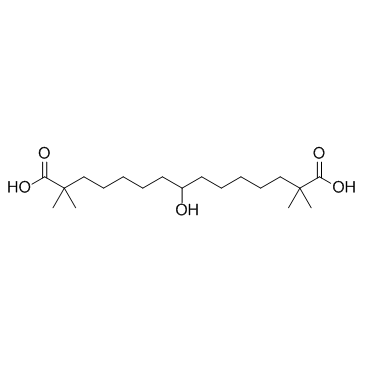738606-46-7
| Name | 8-hydroxy-2,2,14,14-tetramethylpentadecanedioic acid |
|---|---|
| Synonyms |
unii-1ej6z6q368
ETC-1002 Bempedoic Acid ESP-55016 |
| Description | ETC-1002 is an activator of hepatic AMP-activated protein kinase (AMPK). |
|---|---|
| Related Catalog | |
| Target |
AMPK |
| In Vitro | ETC-1002 free acid activates AMP-activated protein kinase in a Ca2+/calmodulin-dependent kinase β-independent and liver kinase β 1-dependent manner, without detectable changes in adenylate energy charge. ETC-1002 is shown to rapidly form a CoA thioester in liver, which directly inhibits ATP-citrate lyase[1]. In cells treated with ETC-1002, increased levels of AMP-activated protein kinase (AMPK) phosphorylation coincide with reduced activity of MAP kinases and decreased production of proinflammatory cytokines and chemokines[2]. |
| In Vivo | A marked and sustained increase in AMPK and ACC phosphorylation is found in rat livers following two weeks of treatment with ETC-1002. ETC-1002 free acid is >100-fold more prevalent than the CoA thioester in rat liver and is associated with AMPK activation[1]. ETC-1002 suppresses thioglycollate-induced homing of leukocytes into mouse peritoneal cavity. In a mouse model of diet-induced obesity, ETC-1002 restores adipose AMPK activity, reduces JNK phosphorylation, and diminishes expression of macrophage-specific marker 4F/80[2]. |
| Kinase Assay | 7.5× compounds are added to a 96-well PolyPlate containing 60 μL of Buffer per well with substrates CoA (200 μM), ATP (400 μM), and [14C]citrate. Reaction is started with 4 μL (300 ng/well) ACL, and the plate is incubated at 37°C for 3 h. Th |
| Cell Assay | Glucose production is measured in primary rat hepatocyte cultures. Cells are cultured in glucose- and phenol red-free DMEM, containing 10 mM lactate, 1 mM pyruvate, and nonessential amino acids. Cells are incubated with and without 0.3 μM glucagon with various concentrations of ETC-1002 (0.1 to 100 μM). Cells are washed twice in GPB. Cells are then incubated for an additional hour to assess glucose production by adding GPB containing equivalent glucagon concentrations without ETC-1002. Cells are incubated for 1 h, and the concentration of glucose in the media is determined[1]. |
| Animal Admin | Rats: Prior to single-dose ETC-1002 administration, Male Wistar Han rats are fasted for 48 h and refed a high-carbohydrate diet for an additional 48 h. For two-week assessment, rats are maintained on standard chow diet and dosed by oral gavage with ETC-1002 at 30 mg/kg/day for two weeks in the morning. Following nutritional staging and/or dosing, food is withdrawn 2 h prior to last the oral dose of ehicle control or ETC-1002 [1]. |
| References |
| Molecular Formula | C19H36O5 |
|---|---|
| Molecular Weight | 344.48600 |
| Exact Mass | 344.25600 |
| PSA | 94.83000 |
| LogP | 4.46990 |
| Storage condition | -20℃ |
